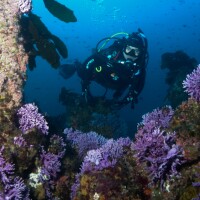Aboard the Sailing Vessel Mir

In the middle of a deep cyan bay on the northwest coast of Bali, Indonesia, protected by a semicircle of mangrove trees and a handful of thatched-roof resorts, a powerful vessel rests nearly motionless on the sea. She's recovering from a torturous journey from Singapore through a monsoon, and her inhabitants are celebrating on the newly refurbished teak deck.
The name on the stern of the classic 113’ sailing ship is Mir, the Russian word for ‘world peace’ and also the name of the original Soviet space station.
But to the crew she’s something more personal. Overhear their tales of the voyage and you’d think Mir was more of a woman than a boat, more of a spirit than a mode of transportation.
Built in Holland in 1910 and originally used to train women for sea voyages, the Mir has brought an eclectic group here to Bali to study, document and protect the coral reefs surrounding nearby Menjangan Island. She is the home base of the Biosphere Foundation (https://biospherefoundation.org), led by Abigail Alling, a marine conservationist who goes by “Gaie,” and a Belgian technician, Mark “Laser” Van Thillo.
Gaie and Laser created the organization back in the early '90s when they were living inside Biosphere 2, an audacious experiment in the Arizona desert. Sealed inside a three-acre self-contained environment for two years with six other humans and many diverse species, they studied the interconnectedness of life. Operating five "biomes" including a farm, a rain forest and a million-gallon “ocean” full of corals and fish, these scientists learned that every action in the environment has a reaction, and that “if the biosphere is happy and healthy, those living in it will be, too.”
For the past 20 years Gaie and Laser have been sailing around the world studying whales and other marine life. They were among the first scientists to call attention to the threats to coral reefs from global warming. In December 2016, they and the crew completed reconstruction of their latest research vessel in Singapore. Mir is the mobile platform for the Biosphere Foundation’s mission “to inspire intelligent use of the earth’s natural resources and empower individuals to become leaders in biosphere stewardship.”
[Watch videos about the outfitting of the Mir.]

The Mir accommodates eight crew members inside spacious working areas and small wood-lined sleeping quarters, and this voyage brings together a delightful hodgepodge team of conservationists. Seasoned sailors and scuba divers work alongside newbies whose first time sailing was the stormy voyage from Singapore to Bali.
There are scientists and artists alike: young people who have left jobs for the sea, people who have taken three months away from the city to experience nature, and several who initially signed on for short apprenticeships and stayed for years.

There’s Carol, a coral reef expert from London, who has been sailing with Gaie and Laser for 16 years. Nadia from Singapore uses her background in video production to create educational material for the Biosphere Foundation’s Studio of the Sea. Dolphin, from Colorado, is the First Mate. He wrote and produced a music video about picking up trash on the beach, set to the tune of “Jammin,'” that got every kid in the neighboring towns singing.
There's Caroline, an event planner from Paris, who organized events around Earth Day 2017 and pushes the cause globally. And Abri and Luisa, a young couple from Jogjakarta who passed up a honeymoon and conventional marriage to live and work on Mir, teaching fellow Indonesians about their impact on the coral reefs.
Each crew member has come on the journey for the shared mission to help understand and protect the environment, but Mir is also what keeps them together. She is their guide, and guider, towards a better planet.
The creed on Mir is “learn from doing,” so every person who steps on board is suddenly necessary. No matter your experience off the boat, how many years you’ve hauled up a sail, how many degrees you have in marine biology - you pull your weight and Mir will protect you; you work hard and she will repay you. On board, work is your education and everyone is constantly learning.
Perhaps that’s what makes Mir such a welcoming vessel for so many types of people – the sailing ship is itself a kind of biosphere. Here, each crew member is an interconnected and necessary element, working together to keep the ship afloat, and our earth alive.





